Abstract
Producing biochar by consuming biomass is an effective way to reduce the environmental impact from biomass waste. This study investigates the influence of biochar made of carya cathayensis peel biomass waste, which is a specific biomass in Zhejiang province, China, on concrete basic mechanical properties. The biochar was added into concrete mixtures in three different patterns, including: (1) additional filler at the ratio of 1%, 2%, 3%, 4% and 5% by cement weight, (2) partial-cement replacement of 1%, 2%, 3%, 4% and 5% by cement weight, and (3) partial sand replacement of 5%, 10%, 15%, 20%, and 25% by sand volume. The strength, porosity and microstructures of the biochar concrete were experimentally investigated and compared with the plain concrete. The highest strength increase appears in concrete with a biochar addition of 5 % sand-replacement volume, and the compressive strength and splitting strength increase by 16.7% and 27.4%, respectively. The ITZ between the biochar particles and the cementitious matrix were tighter and glossier than the ones between the sand and cementitious matrix. The findings suggest that biochar made from carya cathayensis peel can be applied as a sustainable admixture into concrete to improve the basic mechanical properties when used as a partial sand substitute. The optimized addition method suggested is that of replacing 5% to 10% of sand by volume. This study offers an interdisciplinary attempt at valorizing biomass waste in producing green building and construction materials.
1. Introduction
Global development is strongly reliant on the balance of industrial revolution and the exploitation of the natural environment. The increase in greenhouse gases (GHGs) emission is the by-product of the extensive use of natural resource, and strongly threatening to the world environment and global climate change. With regard to the climate crisis, we have become aware that finding alternatives with a lower carbon footprint in many industries is becoming more and more essential. In the building-materials field, an effective way of utilizing supplementary materials which were made from solid wastes was gradually adopted to produce green materials in the form of replacing aggregates [1] or reducing the consumption of cement in concrete, while improving the basic properties of concrete. This reduced the negative impact on the environment from the waste. Most of these waste-made resources were derived from construction or industrial fields, and had proven application techniques [2,3,4].
With the imbalance between the annual output of biomass waste and its environment impacts in China, biochar production was taken into account as a resource-utilization method [5]. Biochar is a renewable source usually produced from solid waste, animal waste, human sewage, agricultural and forestry residues and industrial wastes. These biomasses are treated by high-temperature pyrolysis at around 400–600 °C under the condition of oxygen limitation, which is clean and without GHG emission [6]. It is possible to reduce 13–14% of the annual global energy consumption [5]. Compared with the traditional incineration method, the stable pyrolysis process can significantly reduce the emissions of CO2, CH4, CO, NOx, and SOx in the process of biomass solid-waste treatment. The reduction of the equivalent net greenhouse-gas emission is about 870 kg CO2 (CO2-e) per ton of dry feedstock [7], which has significant negative net CO2 emission and negative global warming potential (GWP) [8]. This biomass-based material has excellent adsorption capacity for non-polar substances, due to its rich pore structure and high specific surface areas [9,10], so that it was widely used in the fields of environmental engineering for sewage purification, heavy-metal adsorption, and soil improvement [7]. Thanks to the positive effects of this pyrolysis production made from biomass waste, when applying it in a particular region in building materials, it fully plays its roles of proving concrete properties [11,12,13,14,15] and ‘carbon sinks’ features, and it is able to make the future building sustainable and green in its development.
Earlier studies suggested that biochar made from wood could enhanced hydration by initially absorbing moisture and later releasing it for the internal curing effect [16,17,18]. It was also found that the addition of 2.5 wt% of wood chip biochar to replace cement improved the mortar fracture energy [16], and the compressive strength of the wood sawdust biochar mortar with the inclusion of 0.08 wt% increased by 20%, compared with the plain mortar, while the water immersion depth and water adsorption of the wood sawdust mortar decreased by about 60% and 38%, respectively [19,20]. With the addition of biochar nanoparticles prepared by pyrolysis of peanut shells and hazelnut shells in cement paste at 1% of the cement mass, the flexural strength and toughness of the cement mortar were improved [21]. Similar findings were found, in that hardwood biochar, hazelnut- and peanut-shell biochar improved concrete compressive strength, and hazelnut- and peanut-shell biochar could also improve the flexible strength [22,23]. Ali Akhtar et al. [24] studied the mechanical properties of concrete partially replaced with cement by biochar prepared from different wastes of poultry manure, rice husk, pulp, and paper-mill sludge. The addition of rice-husk biochar at 0.1 wt% slightly improved the splitting-tensile strength of the concrete. The flexural strength of concrete that was added to poultry litter and rice-husk biochar at 0.1 wt% was 20% higher than that of plain concrete.
The fracture behavior of cementitious composites with carbon-based pyrolysis micro aggregate [25] was studied, based on fractal geometry analysis. The crack-path images of the cementitious matrix were obtained using a scanning electron microscope (SEM), and the fractal dimension was calculated by the box-counting method. It was found that micro aggregates with high carbon content can change the crack path by increasing their curvature. It explains the mechanism of strength enhancement by biochar addition as forming the toughening mechanism of cementitious composites. Besides the mechanical properties studies of biochar enhancing the cementitious composites, the influence of the biochar on the other properties of concrete were also detected extensively [26,27,28,29,30] These previous research studies presented the fact that the influence of biochar on concrete properties partially depends on biochar’s protogenetic physicochemical characteristics, including the variety of biomass solid-waste sources and the different pyrolysis processes [24].
Carya cathayensis is a plant native to the Zhejiang province, China. The pyrolysis of the carya cathayensis peel mass into biochar is an efficient way to reduce its environmental impact. This study focuses on the properties of biochar from carya cathayensis peels and its influence on the basic mechanical properties of concrete, in order to ascertain the appropriate and practical way of utilizing this waste product to improve concrete properties. The carya cathayensis peel biochar was ground to fine particles and added into concrete in three different ways, including partly replacing the cement, and partly replacing the fine aggregates and additional fillers. The compressive strength and splitting-tensile strength of these different biochar concretes were detected, and the influence from the biochar addition was analyzed.
2. Materials and Methods
2.1. Raw Materials
Locally produced ordinary cement of P.O 42.5, well-graded river sand with a fineness modulus of 2.41, and crushed gravels with continuous gradation and maximum size of 10 mm were used for the concrete mixture. Tap water with a Sika high-performance polycarboxylate superplasticizer which has a 25% water-reduction rate was used for the concrete mixing. Besides these basic raw materials, the ground carya cathayensis peel biochar was added into concrete mixtures.
2.2. Characteristics of Carya Cathayensis Peel Biochar
2.2.1. Preparation of Biochar
Carya cathayensis (seen in Figure 1) peels were collected and washed. The cleaned biomass was firstly crushed into smaller pieces and oven dried. Afterwards, the cleaned peels were pyrolyzed at 500 °C. The pyrolysis process took about 2 h and the carbonized peels were completed transformed into biochar particles. These particles were naturally cooled to room temperature and ground into fine particles and sieved. The pile density of this biochar was 0.65 g/cm3. The gradation of sand and the biochar particles with a fineness modulus of 2.77 are seen in Figure 2.
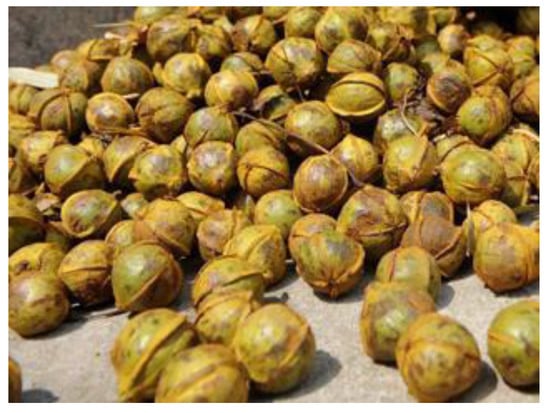
Figure 1.
Carya Cathayensis Peels.
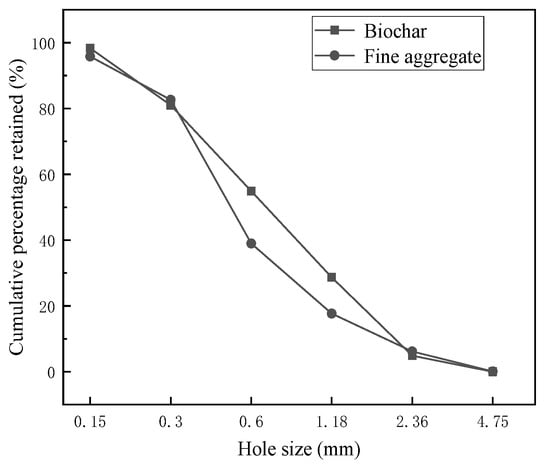
Figure 2.
Particle-size distribution of biochar and fine aggregate.
A semi-quantitative X-ray spectroscopy method was used to determine the composites of the biochar particles quantified. As displayed in Table 1, carbon represents the majority in all the elements. Si, which is an important component for triggering secondary hydration was hardly ever found in the samples. Consequently, it is difficult for this type of biochar to be practically used as a cement substitute in concrete. When it is used in concrete, it acts more like an inorganic component than a cementitious material.

Table 1.
The element content of biochar (%).
2.2.2. Morphology of Biochar
The microstructure of biochar particles was detected using a scanning electron micrograph (SEM), as seen in Figure 3. The micropores, which range from 5 to 20 μm, were generated during pyrolysis by the release of organics and volatiles or they were inherent in the feedstock itself [19]. These pores are highly active in water absorption, which reaches 108.3%, and might adjust the effective w/c ratio during the mixing by acting as a water reservoir in the cement matrix [31], potentially releasing humidity for later cement hydration [32].

Figure 3.
SEM image of biochar particles.
For the purpose of checking biochar influence on the basic mechanical properties of concrete and based on the previous researches’ suggestions [16,18,27], three different addition patterns were designed, including partly replacing cement, additional fine-particle fillers and partly replacing sand.
2.3. Mix Proportions and Concrete Sample Preparation
2.3.1. Mix Proportions
Four sets of 16 groups of concrete mixes including 1 control set P0 without biochar addition were prepared in this study (seen in Table 2). Sets A/B/C represent the biochar addition methods of additional filler, partial cement substitute and partial sand substitute, respectively. In Set A and B, the biochar contents were from 1% to 5% by cement mass at the interval of 1%. In Set C, the biochar contents were from 5% to 25% by sand volume, at an interval of 5%. The concrete grade was designed to be C40. All the biochar was air dried before mixing. Each group of specimens had 3 cube samples.

Table 2.
Mixture proportion of concrete.
In Set A and B, biochar particles were firstly mixed with cement. In Set C, the mixed fine aggregates with biochar particles and sand were prepared in advance. The new fine aggregates of this set were well-graded in terms of gradation, and the fineness modules ranged from 2.41 to 2.56. In each group, the aggregates were mixed firstly for 2 min, and afterwards 70% of the water-sp solution was added in and mixed for 2 min. The rest of the water was gradually poured in at the end. The mixing continued for another 2 min. Before casting, the slump of all the concrete was tested.
2.3.2. Specimen Preparing and Curing
The fresh mixture was layered into the cube mold of 100 mm × 100 mm × 100 mm and vibrated sufficiently. The casted specimens were immediately covered with plastic film for 24 h before de-molding. Then, all the specimens were placed in a standard curing room with a temperature of 20 ± 2 °C and humidity above 95% for curing for 28 days. These specimens were tested for variations in compressive strength and splitting-tensile strength.
2.4. Testing Programs
2.4.1. Strength Testing
Compressive force was loaded onto these biochar concrete specimens at a uniform speed of 5 kN/s. Splitting-tensile force was loaded at 0.5 kN/s. The compressive strength and split-tensile strength were measured according to the Standard of Test Methods for Mechanical Properties of Ordinary Concrete (GB/T50081). The size effect was considered in the testing results.
2.4.2. SEM and Mercury Injection Meter (MIP) Testing
The cementitious matrix samples were collected from each specimen and the hydration process was terminated with anhydrous alcohol. The samples which were going to be used for SEM scanning were dried at 105 °C for 24 h, and then the surfaces were polished to smooth and thinly coated with metal, using an ion-sputtering instrument. Afterwards, the SEM scanning test was conducted to detect the microstructure morphology.
The samples which were going to be used for conducting the MIP test were dried at 105 °C for 72 h. The porosity of each sample was analyzed using MC Auto Pore V 9600 equipment at the pressure range of 0.5–33,000 psi.
3. Results and Discussion
3.1. Slump of Biochar Concrete
The slump test results are seen in Table 3. With regard to the operational error, the biochar addition would influence the workability of the concrete mixture when it is used as a sand substitute. A significant slump decrease could be found in Set C. This could be due to its complicated surface morphology and high surface area. In Set C, with the relatively higher amount of biochar addition when compared to the other two sets, higher surface areas are introduced and sufficient cement paste for wrapping around and keeping the workability of the mixture. The mixture design is constant from set to set except for the biochar addition pattern. In this case, concrete with higher biochar addition would have a lower slump when few extra strategies are applied for maintaining workability.

Table 3.
Slump testing results.
3.2. Porosity of Biochar Concrete
The porosity test results of each concrete group that was measured using the mercury injection test are seen in Table 4. The biochar concretes of A2 and C1 obtain almost the lowest porosity, of 7.9% and 7.1%, respectively, which are significantly lower than the control set P0. The porosity results of set B are all larger than the control set.

Table 4.
The porosity of each concrete group.
3.3. Micro Structures of Biochar Concrete
According to the SEM testing, the biochar particles have a significant fraction and a coarse surface, as seen in Figure 3. When detecting the porous structure of the biochar concrete, it was found that the interfacial transition zone between the biochar particles and cementitious materials was smoother and more securely tied than the zone between the sand and the matrix, as seen in Figure 4. It suggested that the particles of biochar induced the positive filler effect which was able to improve the ITZ and lower the voids of the cementitious matrix.
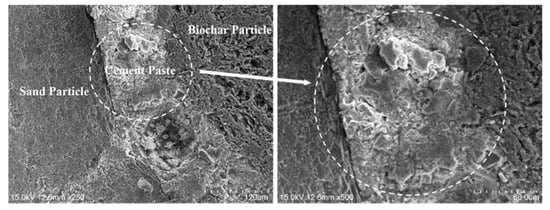
Figure 4.
Interface between cementitious matrix and biochar/sand particles.
3.4. Compressive and Splitting-Tensile Strength
3.4.1. Compressive Strength
The test results for compressive strength of each group at the age of 28 days are illustrated in Figure 5, Figure 6 and Figure 7. The compressive-strength dependence of each type of biochar concrete on biochar addition shows a third-order nonlinear relationship. In Set A, the samples with biochar addition of 1%, 2% and 3% matched the designed C40 grade, as expected. Within these three groups, the concrete with 2% biochar resulted in a slight increase in compressive strength, which was 3.5% higher than that of the control set P0. When the biochar addition was beyond 2%, the increasing biochar-concrete compressive strength showed an obvious decreasing tendency and became lower than C40, as seen in group A4 and A5. In set B, with the biochar-cement-replacement increasing, the compressive strength of each biochar concrete significantly dropped. The ones with a 5%wt biochar replacement of cement dropped 26.7% compared to the control set. In set C, the compressive strength of the biochar concrete was no less than that of the plain concrete. Among these five different groups, the highest compressive strength of the specimens appeared in group C5, which had a 5% biochar replacement of sand. It reached 56 MPa and was 16.7% higher than the control set P0.
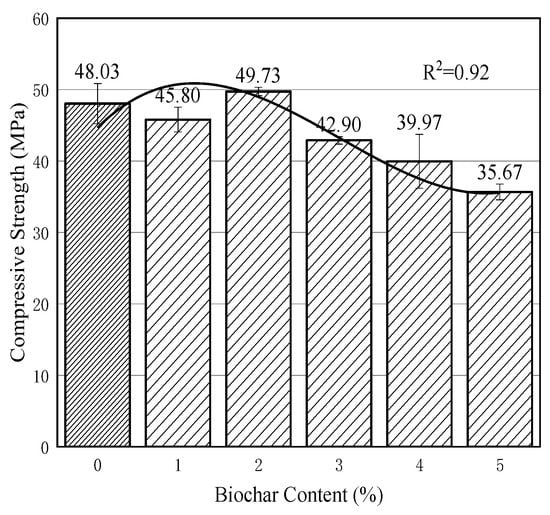
Figure 5.
Compressive strength results of Set A.
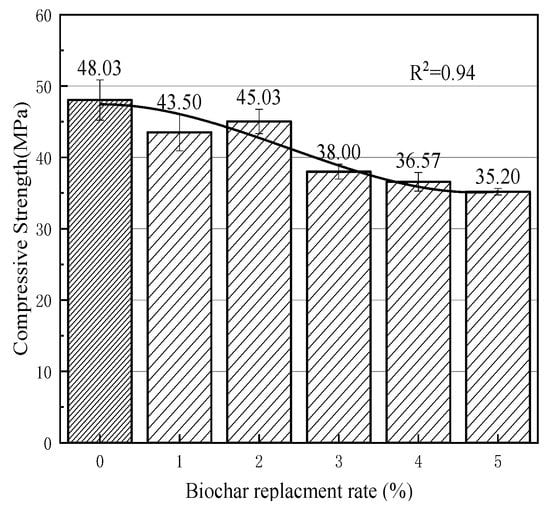
Figure 6.
Compressive strength results of Set B.
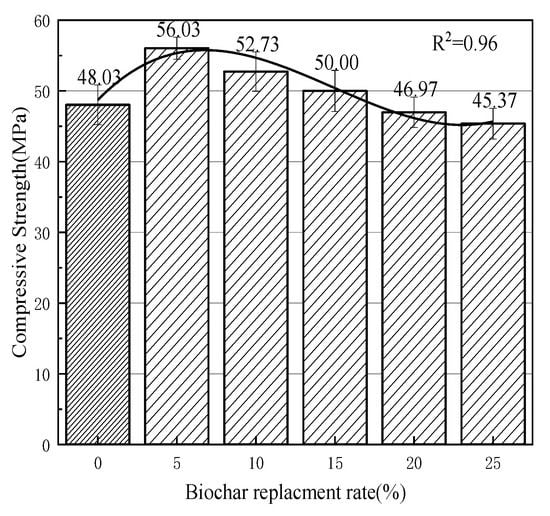
Figure 7.
Compressive strength results of Set C.
These testing results indicate that when biochar is added into concrete mixtures as part of a cement substitute, it has a negative influence on concrete compressive-strength growth. This was different from the previous research which used wood sawdust [15]. It could be understood that, compared to wood sawdust, the carya cathayensis peel biochar has little cementitious components inside, so that it hardly participates at all in the hydration process. In this case, this type of biochar particle acts more as an inorganic filler than cementitious materials such as wood sawdust. When the cement was partly replaced by this completed carbonized material, as in set B, the cement was reduced, which led to the increase in effective w/c and a reduction of cementitious materials. This could be critical for the hydration process. As a consequence, the micropore structures and the inter-transition-zones growth could be negatively influenced, which leads to the compressive strength dropping. The more biochar used, the lower the compressive strength.
However, in set A and set C, the addition of biochar creates concrete with better performance in compressive strength. This indicates a similar tendency to the previous research which used the lignocellulosic biochar [20]. The increased strength may relate to the water absorption and retention capacity of the biochar [22,33]. Because of the porous microstructure and large specific surface areas, part of the water is capillary absorbed by the biochar particles during mixing, which leads to the decrease in the effective w/c ratio of the mixtures; the compressive strength of the concrete could be improved further. However, there is a balance between the capillary effect and the compressive strength increasing. In set A, the biochar particles acted as additional inorganic aggregates, so that the sand ratios of the concrete mixtures were increased. On one hand, with a reasonable increase in the sand ratio, the water retention and workability of the concrete could be maintained as good or increased somehow. On the other hand, with the increase in biochar addition, the capillary effect became stronger, which may have resulted in less mortar surrounding the aggregates during mixing. In this case, the viscidity of the concrete mixtures could be negatively influenced so that the compressive strength of the concrete would decrease. Although in set C the amount of biochar was much higher than in set A, the biochar concrete compressive strength was generally higher than in set A. With this method of biochar addition, the sand was partly replaced by the biochar, so that the sand ratios were consistent with the control set P0. The protogenous pores which were introduced by the biochar particles had a capillary effect, and lowered the effective w/c ratio of the concrete during mixing. The absorbed moisture that was sustained in the internal reservoirs of the biochar pores could provide a favorable internal humidity environment for the surrounding cementitious paste for later cement hydration, which could create better and denser micropore structures of the cement matrix and improve the concrete compressive strength. However, with the increasing addition of biochar, which was beyond 10% of the sand, a higher number of protogenous pores were introduced, which created a more connected capillary-pore network in the cementitious matrix, so that strength loss could be generated [34,35]. In this case, the balance between the reduction in effective w/c and the addition of biochar was broken by the inclusion of a higher amount of biochar. As a result, compressive-strength loss was found in concrete with more addition of biochar.
3.4.2. Splitting-Tensile Strength
The splitting-tensile strength results are presented in Figure 8, Figure 9 and Figure 10. The dependence of this strength on biochar addition shows a third-order nonlinear relationship. In set A, an increase in strength is found with the addition of biochar climbing from 1% to 2%, and in A2 it is 30% higher than in the control set P0. Beyond 2%, the splitting-tensile strength declines slightly, but is almost as high as in the plain concrete. In set B, the splitting-tensile strength of the biochar concrete is nearly in the same grade as in the control set P0. In set C, the biochar concrete specimens all have better splitting-tensile strength performance than in P0. The highest splitting-tensile strengths appear in the C5 and C10 groups, which achieve around 28% higher than control set P0. With the increase in biochar-sand replacement from 15% to 25%, a reduction tendency is found, although it is still higher than in P0.
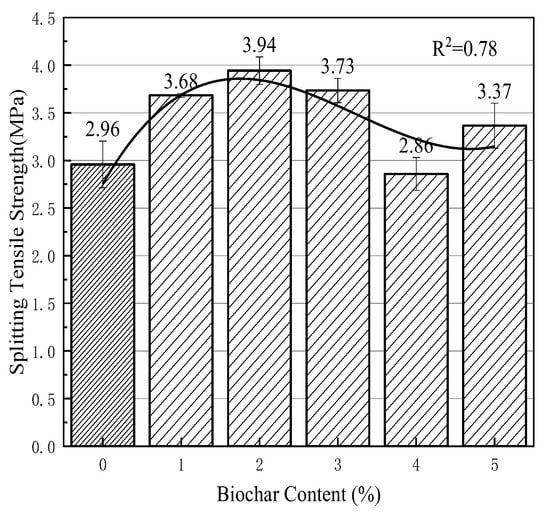
Figure 8.
Splitting-tensile-strength testing results of Set A concrete.
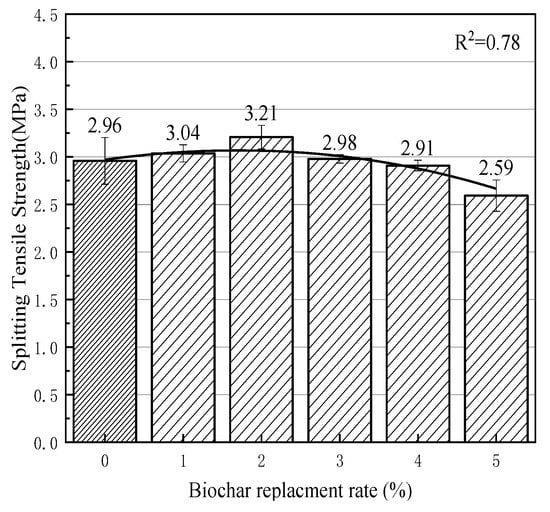
Figure 9.
Splitting-tensile-strength testing results of Set B concrete.
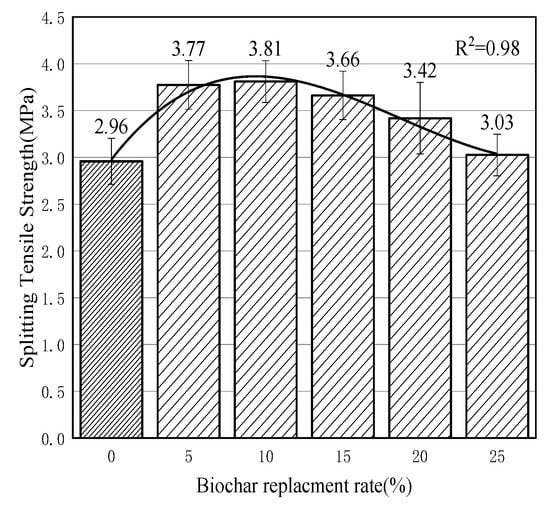
Figure 10.
Splitting-tensile-strength testing results of Set C concrete.
The splitting-tensile strength of the specimen is related to the homogeneity of the tensile plane. As seen in Figure 4, the connection between the biochar particle and the cement paste is close and tight, without obvious gaps, compared to the boundary between the sand particles and the cementitious matrix. This finding is consistent with that of the previous study of biochar mortar [27]. Under the tensile load, the normal concrete specimens are usually split into two pieces which are detached at the boundary gap between the sand and the paste. However, in biochar concrete, the close, smooth, connected zones of biochar-paste strengthen the boundaries against the splitting-tensile strength, so that the micro-cracks neither extend into this region nor form a bridge with other cracks around the biochar particles, as seen in the sample which was collected after the splitting-tensile test in Figure 11. Moreover, the micro-cracks do not pass through the biochar particles, either.
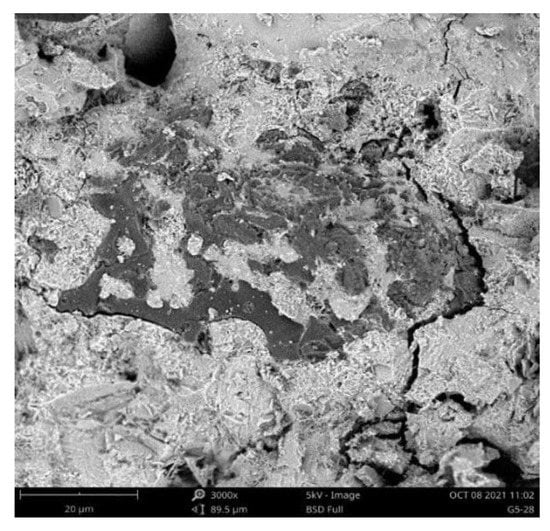
Figure 11.
Micro-cracks developing around the biochar particles.
4. Conclusions
In this study, three ways of adding carya cathayensis peel biochar to concrete were adopted, including partly replacing cement, and partly replacing sand and extra inorganic fillers. The influence of these three ways of biochar addition on the basic mechanical properties of concrete of compressive strength and splitting-tensile strength were experimentally investigated. The microstructural properties of biochar itself and biochar concrete were extensively detected, too. From the experimental results, the following conclusions and suggestions for further research of this recycled concrete could be addressed as:
- Carya cathayensis peel biochar has a well-developed microporous cellular structure which had a high specific surface area. When it is added to the concrete mixture, it is potentially active in capillary absorbing and sustaining moisture during mixing, which could influence the effective w/c ratio and the concrete compressive strength further.
- For the kind of biochar without organic elements, it is suggested that it should be added to the cementitious mixture as an extra filler or sand substitute. For the optimized addition ratio for the former, the dosage could be limited to 2% of cement by weight in the case of all the concrete-mixture design parameters being kept the same. Otherwise, extra water for mixing should be considered for this super-high specific-surface-area material.
- Adding this biochar by replacing sand that is limited to 10% by volume is feasible for significantly improving concrete compressive strength, due to its capillary-absorption and moisture-sustaining properties. Beyond 10% of sand replacement, this porous material would introduce more initial pores into the concrete matrix, which could cause higher porosity and lower compressive strength of concrete.
- The ITZ between cementitious matrix and biochar particles was found to be much tighter and glossier than the ITZ with sand. These closer and smoother connected zones of biochar-paste strengthened the boundaries against splitting-tensile strength. The highest splitting-tensile strengths appeared in the C5 and C10 groups, which were about 28% higher than in the normal concrete.
The findings prove the possibility of using carya cathayensis peel biochar to improve concrete strength, especially when added as a partial replacement for sand. The mechanism of strength reinforcement is analyzed, as better inter-transition structures are generated by the biochar particles. This provides the potential for extensively consuming the biomass of carya cathayensis peel and for carbon storage in producing green building materials in the civil-engineering field, which could meanwhile reduce the negative environmental impact from this biomass. Based on the findings of this study, further quantitative investigation on biochar influence on effective w/c ratio and on the hydration process could be carried out. This is able to provide deep insight into the mechanism of ITZ between the biochar particles and cementitious matrix regarding the improvement in concrete properties t.
Author Contributions
Investigation, Z.L. and W.Z.; writing—original draft, W.X.; writing—review and editing, W.X.; project administration, Z.L. All authors have read and agreed to the published version of the manuscript.
Funding
This research was funded by the Research funding of Zhejiang University of Science and Technology grant number 2021QN077.
Institutional Review Board Statement
Not applicable.
Informed Consent Statement
Not applicable.
Data Availability Statement
The data presented in this study are available on request from the corresponding author.
Conflicts of Interest
The authors declare no conflict of interest.
References
- Zhong, X.; Deetman, S.; Tukker, A.; Behrens, P. Increasing material efficiencies of buildings to address the global sand crisis. Nat. Sustain. 2022, 5, 389–392. [Google Scholar] [CrossRef]
- Leng, Y.; Rui, Y.; Zhonghe, S.; Dingqiang, F.; Jinnan, W.; Yonghuan, Y.; Qiqing, L.; Xiang, H. Development of an environmental Ultra-High Performance Concrete (UHPC) incorporating carbonated recycled coarse aggregate. Constr. Build. Mater. 2023, 362, 129657. [Google Scholar] [CrossRef]
- Fu, B.; Liu, K.; Chen, J.; Teng, J. Concrete reinforced with macro fibres recycled from waste GFRP. Constr. Build. Mater. 2021, 310, 125063. [Google Scholar] [CrossRef]
- Malazdrewicz, S.; Ostrowski, K.A.; Sadowski, Ł. Self-compacting concrete with recycled coarse aggregates from concrete construction and demolition waste–Current state-of-the art and perspectives. Constr. Build. Mater. 2023, 370, 130702. [Google Scholar] [CrossRef]
- Wang, F.; Harindintwali, J.D.; Yuan, Z.; Wang, M.; Li, S.; Yin, Z.; Huang, L.; Fu, Y.; Li, L.; Chang, S.X.; et al. Technologies and perspectives for achieving carbon neutrality. Innovation 2021, 2, 100180. [Google Scholar] [CrossRef]
- Bridgwater, A.V. Renewable fuels and chemicals by thermal processing of biomass. J. Chem. Eng. 2003, 91, 87–102. [Google Scholar] [CrossRef]
- Roberts, K.G.; Gloy, B.A.; Joseph, S.; Scott, N.R.; Lehmann, J. Life cycle assessment of biochar systems: Estimating the energetic, economic, and climate change potential. Environ. Sci. Technol. 2010, 44, 827–833. [Google Scholar] [CrossRef]
- Alhashimi, H.A.; Aktas, C.B. Life cycle environmental and economic performance of biochar compared with activated carbon: A meta-analysis. Resour. Conserv.Recycl. 2017, 118, 13–26. [Google Scholar] [CrossRef]
- Kloss, S.; Zehetner, F.; Dellantonio, A.; Hamid, R.; Ottner, F.; Liedtke, V.; Schwanninger, M.; Gerzabek, M.H.; Soja, G. Characterization of slow pyrolysis biochars: Effects of feedstocks and pyrolysis temperature on biochar properties. J. Environ. Qual. 2012, 41, 990–1000. [Google Scholar] [CrossRef]
- Xie, T.; Reddy, K.R.; Wang, C.W.; Yargicoglu, E.; Spokas, K. Characteristics and applications of biochar for environmental remediation: A review. Crit. Rev. Environ. Sci. Technol. 2015, 45, 939–969. [Google Scholar] [CrossRef]
- Gupta, S.; Kua, H.W. Factors determining the potential of biochar as a carbon capturing and sequestering construction material: Critical review. J. Mater. Civ. Eng. 2017, 29, 04017086. [Google Scholar] [CrossRef]
- Gupta, S.; Kua, H.W.; Cynthia, S.Y.T. Use of biochar-coated polypropylene fibers for carbon sequestration and physical improvement of mortar. Cem. Concr. Compos. 2017, 83, 171–187. [Google Scholar] [CrossRef]
- Tan, K.; Qin, Y.; Du, T.; Li, L.; Zhang, L.; Wang, J. Biochar from waste biomass as hygroscopic filler for pervious concrete to improve evaporative cooling performance. Constr. Build. Mater. 2021, 287, 123078. [Google Scholar] [CrossRef]
- Goldman, A.; Bentur, A. The influence of microfillers on enhancement of concrete strength. Cem. Concr. Res. 1993, 23, 962–972. [Google Scholar] [CrossRef]
- Cuthbertson, D.; Berardi, U.; Briens, C.; Berruti, F. Biochar from residual biomass as a concrete filler for improved thermal and acoustic properties. Biomass Bioenergy 2019, 120, 77–83. [Google Scholar] [CrossRef]
- Gupta, S.; Kua, H.W. Effect of water entrainment by pre-soaked biochar particles on strength and permeability of cement mortar. Constr. Build. Mater. 2018, 159, 107–125. [Google Scholar] [CrossRef]
- Mo, L.; Fang, J.; Huang, B.; Wang, A.; Deng, M. Combined effects of biochar and MgO expansive additive on the autogenous shrinkage, internal relative humidity and compressive strength of cement pastes. Constr. Build. Mater. 2019, 229, 116877. [Google Scholar] [CrossRef]
- Gupta, S.; Pang, S.D.; Kua, H.W. Waste Valorisation using biochar for cement replacement and internal curing in ultra-high performance concrete. J. Clean. Prod. 2019, 238, 117876. [Google Scholar]
- Gupta, S.; Kua, H.W.; Low, C.Y. Use of biochar as carbon sequestering additive in cement mortar. Cem. Concr. Compos. 2018, 87, 110–129. [Google Scholar] [CrossRef]
- Gupta, S.; Kua, H.W.; Pang, S.D. Effect of biochar on mechanical and permeability properties of concrete exposed to elevated temperature. Constr. Build. Mater. 2019, 234, 117338. [Google Scholar] [CrossRef]
- Khushnood, R.A.; Ahmad, S.; Restuccia, L.; Spoto, C.; Jagdale, P.V.; Tulliani, J.-M.; Ferro, G.A. Carbonized nano/microparticles for enhanced mechanical properties and electromagnetic interference shielding of cementitious materials. Front. Struct. Civ. Eng. 2016, 10, 209–213. [Google Scholar] [CrossRef]
- Chow, W.C.; Yun, H.D.; Lee, J.Y. Mechanical properties of mortar containing bio-char from pyrolysis. J. Korea Inst. Struct. Maint. Insp. 2012, 16, 67–74. [Google Scholar]
- Restuccia, L.; Ferro, G.A. Promising low cost carbon-based materials to improve strength and toughness in cement composites. Constr. Build. Mater. 2016, 126, 1034–1043. [Google Scholar] [CrossRef]
- Akhtar, A.; Sarmah, A.K. Novel biochar-concrete composites: Manufacturing, characterization and evaluation of the mechanical properties. Sci. Total Environ. 2018, 616–617, 408–416. [Google Scholar] [CrossRef]
- Restuccia, L.; Reggio, A.; Ferro, G.; Kamranirad, R. Fractal analysis of crack paths into innovative carbon-based cementitious composites. Theor. Appl. Fract. Mech. 2017, 90, 133–141. [Google Scholar] [CrossRef]
- Berardi, U.; Naldi, M. The impact of the temperature dependent thermal conductivity of insulating materials on the effective building envelope performance. Energy Build. 2017, 144, 262–275. [Google Scholar] [CrossRef]
- Yang, S.; Wi, S.; Lee, J.; Lee, H.; Kim, S. Biochar-red clay composites for energy efficiency as eco-friendly building materials: Thermal and mechanical performance. J. Hazard. Mater. 2019, 373, 844–855. [Google Scholar] [CrossRef]
- Patwa, D.; Chandra, A.; Ravi, K.; Sreedeep, S. Influence of biochar particle size fractions on thermal and mechanical properties of biochar-amended soil. J. Mater. Civ. Eng. 2021, 33, 04021236. [Google Scholar] [CrossRef]
- Mensah, R.A.; Shanmugam, V.; Narayanan, S.; Razavi, S.M.; Ulfberg, A.; Blanksvärd, T.; Sayahi, F.; Simonsson, P.; Reinke, B.; Försth, M.; et al. Biochar-Added Cementitious Materials—A Review on Mechanical, Thermal, and Environmental Properties. Sustainability 2021, 13, 9336. [Google Scholar] [CrossRef]
- Quintaliani, C.; Merli, F.; Fiorini, C.V.; Corradi, M.; Speranzini, E.; Buratti, C. Vegetal Fiber Additives in Mortars: Experimental Characterization of Thermal and Acoustic Properties. Sustainability 2022, 14, 1260. [Google Scholar] [CrossRef]
- Shafie, S.T.; Salleh, M.M.; Hang, L.L.; Rahman, M.; Ghani, W.A. Effect of pyrolysis temperature on the biochar nutrient and water retention capacity. J. Purity Util. React. Environ. 2012, 1, 293–307. [Google Scholar]
- Mrad, R.; Chehab, G. Mechanical and Microstructure Properties of Biochar-Based Mortar: An Internal Curing Agent for PCC. Sustainability 2019, 11, 2491. [Google Scholar] [CrossRef]
- Gupta, S.; Kua, H.W.; Koh, H.J. Application of biochar from food and wood waste as green admixture for cement mortar. Sci. Total Environ. 2018, 619–620, 419–435. [Google Scholar] [CrossRef]
- Tang, L. A study of the quantitative relationship between strength and pore-size distribution of porous materials. Cem. Concr. Res. 1986, 16, 87–96. [Google Scholar]
- Nambiar, E.; Ramamurthy, K. Air-void characterisation of foam concrete. Cem. Concr. Res. 2007, 37, 221–230. [Google Scholar] [CrossRef]
Disclaimer/Publisher’s Note: The statements, opinions and data contained in all publications are solely those of the individual author(s) and contributor(s) and not of MDPI and/or the editor(s). MDPI and/or the editor(s) disclaim responsibility for any injury to people or property resulting from any ideas, methods, instructions or products referred to in the content. |
© 2023 by the authors. Licensee MDPI, Basel, Switzerland. This article is an open access article distributed under the terms and conditions of the Creative Commons Attribution (CC BY) license (https://creativecommons.org/licenses/by/4.0/).